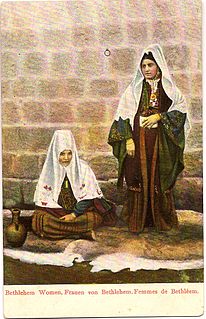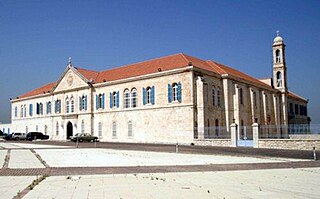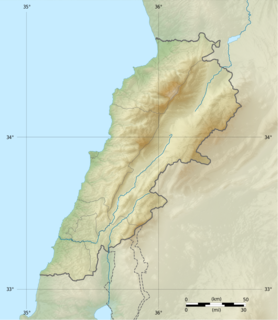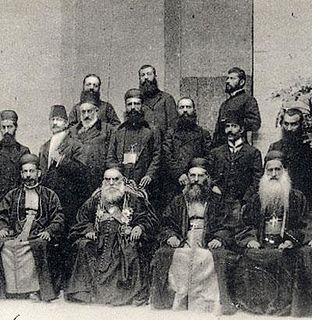
Maron, also called Maroun or Maro, was a 4th-century Syriac Christian hermit monk in the Taurus Mountains whose followers, after his death, founded a religious Christian movement that became known as the Syriac Maronite Church, in full communion with the Holy See and the Catholic Church. The religious community which grew from this movement are the modern Maronites.

Mount Lebanon is a mountain range in Lebanon. It averages above 2,500 m (8,200 ft) in elevation.

Arab Christians are Arabs of the Christian faith. Many are descended from ancient Arab Christian clans that did not convert to Islam, such as the Kahlani Qahtanite tribes of Yemen who settled in Transjordan and Syria, as well as Arabized Christians, such as Melkites and Antiochian Greek Christians. Arab Christians, forming Greek Orthodox and Greek Catholic communities, are estimated to be 520,000–703,000 in Syria, 221,000 in Jordan, 134,130 in Israel and around 50,000 in Palestine. There is also a sizable Arab Christian Orthodox community in Lebanon and marginal communities in Iraq, Turkey and Egypt. Emigrants from Arab Christian communities make up a significant proportion of the Middle Eastern diaspora, with sizable population concentrations across the Americas, most notably in Argentina, Brazil, Chile, Mexico, Venezuela, Colombia, and the US.
Garshuni or Karshuni are Arabic writings using the Syriac alphabet. The word "Garshuni" was used by George Kiraz to coin the term "garshunography", denoting the writing of one language in the script of another.

Hunayn ibn Ishaq al-Ibadi was an influential Arab Nestorian Christian translator, scholar, physician, and scientist. He and his students transmitted their Arabic and Syriac translations of many classical Greek texts throughout the Islamic world, during the apex of the Islamic Abbasid Caliphate.
The Mardaites or al-Jarajima, inhabited the highland regions of the Nur Mountains.
The Mardaites were early Christians following either Miaphysitism or Monothelitism and bear a possible, but unconfirmed, relation to the Maronites. Little is known about their ethnicity, it has been speculated that they might have been Persians or Armenians, yet other sources claim them to have been native to the Levant or possibly even from the Arabian peninsula. Their other Arabic name, al-Jarājimah, suggests that some were natives of the town Jurjum in Cilicia, however the name also exists in Arabic and translates to "Sick" or "Insane" as is the case with the word "Mareed", due to their fierce fighting style and retaliation against attacks. They were joined later by various escaped slaves and peasants during their insurgency and were said to have claimed territory from "the Holy City" to the "Black Mountain".

The Maronite Church is an Eastern Catholic sui iuris particular church in full communion with the Pope and the worldwide Catholic Church, with self-governance under the Code of Canons of the Eastern Churches. It is headed by Patriarch Bechara Boutros al-Rahi since 2011. Officially known as the Syriac Maronite Church of Antioch, it is part of Syriac Christianity by liturgy and heritage.

Qurnat as Sawdā’ in Jabal al-Makmel is the highest point in Lebanon and the Levant, at 3,093 meters above sea level.
Sahl ibn Bishr al-Israili, also known as Rabban al-Tabari and Haya al-Yahudi, was a Syriac Christian astrologer, astronomer and mathematician from Tabaristan. He was the father of Ali ibn Sahl the famous scientist and physician, who became a convert to Islam.

Gabriel Sionita was a learned Maronite, famous for his role in the publication of the 1645 Parisian polyglot of the Bible.
Georg Graf was a German Orientalist. One of the most important scholars of Christian-Arabic literature, his 5-volume Geschichte der christlichen arabischen Literatur is the foundational text in the field.
Mahbūb ibn-Qūṣṭānṭīn was a 10th-century Arabic Christian writer and historian, best known for his lengthy Kitab al-'Unwan. He was the Melkite bishop of Manbij, in Syria.

The Maronites are a Christian group who adhere to the Syriac Maronite Church with the largest population around Mount Lebanon in Lebanon. The Maronite Church is an Eastern Catholic sui iuris particular church in full communion with the Pope and the Catholic Church, with self-governance under the Code of Canons of the Eastern Churches, one of more than a dozen individual churches in full communion with the Holy See. They derive their name from the Syriac Christian saint Maron, whose followers migrated to the area of Mount Lebanon from their previous location of residence around the area of Antioch, establishing the nucleus of the Syriac Maronite Church. Some Maronites argue that they are of Mardaite ancestry, but most historians reject such claims. Maronites were able to maintain an independent status in Mount Lebanon and its coastline after the Muslim conquest of the Levant, keeping their Christian religion, and even the distinctive Aramaic language as late as the 19th century.
Maronites in Israel belong to the Maronite Catholic Church, which has historically been tied with Lebanon. They derive their name from the Syriac Saint Maron, whose followers moved to Mount Lebanon from northern Syria, establishing the Maronite Church, most of whose members currently live in Lebanon. The Maronites in Israel encompass the long existing Maronite community in Jish area and the families of former South Lebanon Army members, 7,000 of them who fled South Lebanon in April–May 2000 to Israel. Of the 7,000 SLA and their families who left their family members and belongings in Lebanon, just 2,700 have remained in Israel. Over the years, many of them decided to return home to Lebanon, while others left for Europe and the US.
Syriac studies is the study of the Syriac language and Syriac Christianity. A specialist in Syriac studies is known as a Syriacist. Specifically, British, French, and German scholars of the 18th and 19th centuries who were involved in the study of Syriac/Aramaic language and literature were commonly known by this designation, at a time when the Syriac language was little understood outside Assyrian, Syriac Christian and Maronite Christian communities. In Germany the field of study is distinguished between Aramaistik and Neuaramaistik.
Lebanese Maronite Christians refers to Lebanese people who are adherents of the Maronite Church in Lebanon, which is the largest Christian denomination in the country.
Gabriel ibn al-Qilai was a Lebanese Christian religious, belonging to the Maronite Church. Al-Qilai entered in the Franciscan Order to 1470 and was consecrated bishop of Maronites in Cyprus in 1507.
Elijah, Eliya, or Elias of Nisibis was a Nestorian cleric who served as bishop of Beth Nuhadra (1002–1008) and archbishop of Nisibis (1008–1046). He has been called the most important Christian writer in Arabic—or even throughout non-Christian Asia—during the 11th century. He is best known for his Chronography, which is an important source for the history of Sassanid Persia.
Aramaic studies is the study of the Aramaic language and Syriac Christianity. A specialist in Aramaic studies is known as a Aramaicist. British, French, and German scholars of the 18th and 19th centuries who were involved in the study of Syriac/Aramaic language and literature were commonly known by the designation Syriacist (a scholar of Syriac studies, at a time when the Syriac language was little understood outside Assyrian, Syriac Christian and Maronite Christian communities. In Germany the field of study is distinguished between Aramaistik and Neuaramaistik.










